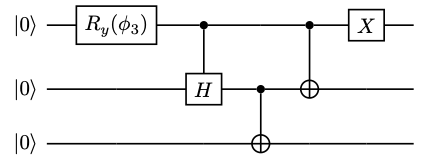W-state on:
[Wikipedia]
[Google]
[Amazon]
The W state is an entangled
 The W state is the representative of one of the two non-biseparable classes of three-qubit states, the other being the
The W state is the representative of one of the two non-biseparable classes of three-qubit states, the other being the
quantum state
In quantum physics, a quantum state is a mathematical entity that embodies the knowledge of a quantum system. Quantum mechanics specifies the construction, evolution, and measurement of a quantum state. The result is a prediction for the system ...
of three qubits
In quantum computing, a qubit () or quantum bit is a basic unit of quantum information—the quantum version of the classic binary bit physically realized with a two-state device. A qubit is a two-state (or two-level) quantum-mechanical system, ...
which in the bra-ket notation has the following shape
:
and which is remarkable for representing a specific type of multipartite entanglement
In the case of systems composed of m > 2 subsystems, the classification of quantum-entangled states is richer than in the bipartite case. Indeed, in multipartite entanglement apart from fully separable states and fully entangled states, there ...
and for occurring in several applications in quantum information theory
Quantum information is the information of the state of a quantum system. It is the basic entity of study in quantum information theory, and can be manipulated using quantum information processing techniques. Quantum information refers to both t ...
. Particles prepared in this state reproduce the properties of Bell's theorem
Bell's theorem is a term encompassing a number of closely related results in physics, all of which determine that quantum mechanics is incompatible with local hidden-variable theories, given some basic assumptions about the nature of measuremen ...
, which states that no classical theory of local hidden variables can produce the predictions of quantum mechanics. The state is named after Wolfgang Dür, who first reported the state together with Guifré Vidal
Guifré Vidal is a Spanish physicist who is working on quantum many-body physics using analytical and numerical techniques. In particular, he is one of the leading experts of tensor network state implementations such as time-evolving block de ...
, and Ignacio Cirac
Juan Ignacio Cirac Sasturain (born 11 October 1965), known professionally as Ignacio Cirac, is a Spanish physicist. He is one of the pioneers of the field of quantum computing and quantum information theory. He was awarded the 2013 Wolf Prize ...
in 2000.
Properties
 The W state is the representative of one of the two non-biseparable classes of three-qubit states, the other being the
The W state is the representative of one of the two non-biseparable classes of three-qubit states, the other being the Greenberger–Horne–Zeilinger state
In physics, in the area of quantum information theory, a Greenberger–Horne–Zeilinger (GHZ) state is an entangled quantum state that involves at least three subsystems (particle states, qubits, or qudits). Named for the three authors that ...
, . The and states represent two very different kinds of tripartite entanglement, as they cannot be transformed (not even probabilistically) into each other by local quantum operations.
This difference is, for example, illustrated by the following interesting property of the W state: if one of the three qubits is lost, the state of the remaining 2-qubit system is still entangled. This robustness of W-type entanglement contrasts strongly with the GHZ state, which is fully separable after loss of one qubit.
The states in the W class can be distinguished from all other 3-qubit states by means of multipartite entanglement measures. In particular, W states have non-zero entanglement across any bipartition, while the 3-tangle vanishes, which is also non-zero for GHZ-type states.
Generalization
The notion of W state has been generalized for qubits and then refers to the quantum superposition with equal expansion coefficients of all possible pure states in which exactly one of the qubits is in an "excited state" , while all other ones are in the "ground state" : : Both the robustness against particle loss and theLOCC
LOCC, or local operations and classical communication, is a method in quantum information theory where a local (product) operation is performed on part of the system, and where the result of that operation is "communicated" classically to another ...
-inequivalence with the (generalized) GHZ state also hold for the -qubit W state.
Applications
In systems in which a single qubit is stored in an ensemble of many two-level systems the logical "1" is often represented by the W state, while the logical "0" is represented by the state . Here the W state's robustness against particle loss is a very beneficial property ensuring good storage properties of these ensemble-based quantum memories.See also
*NOON state
In quantum optics, a NOON state or N00N state is a quantum-mechanical many-body entangled state:
: , \text \rangle = \frac, \,
which represents a superposition of ''N'' particles in mode ''a'' with zero particles in mode ''b'', and vice ver ...
References
{{DEFAULTSORT:W State Quantum information theory Quantum states